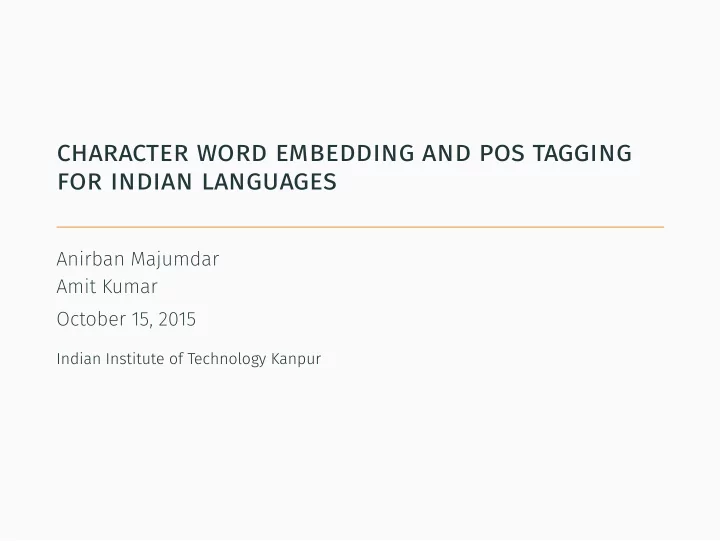

character word embedding and pos tagging for indian languages Anirban Majumdar Amit Kumar October 15, 2015 Indian Institute of Technology Kanpur
motivation
motivation ∙ Distributed word representations are proven to be a powerful tool. ∙ Word embeddings captures syntactic and semantic information about word. ∙ In task like POS Tagging intra-word information could be very useful which is ignored in word embeddings. ∙ Character embeddings can be use to capture the intra-word information [1]. ∙ Why not enhance the word embedding to use intra-word information by using character embedding. 2
related work ∙ Learning Character-level Representations by Santos et al. ∙ Some results on english language 3
goal
goal ∙ Learning intra-word feature extraction of words using character embedding. ∙ Enhancing word embedding using the character embedding of the word. ∙ Using enhanced word embedding to perform task like POS Tagging. 5
challenges
challenges ∙ Character embedding relatively new field. ∙ Extracting the morphological information from character embedding ∙ Use of Enhanced word vectors for NLP tasks such as POS tagging in Indian Languages like Hindi, Bengali 7
roadmap
data set ∙ Wikipedia english corpus (16 million words, Vocab Size: 70k) ∙ Training data for POS tagger : wikipedia hindi corpus (200 MB) ∙ Wikipedia Corpus for Bengali (100 MB) 9
data collection ∙ Cleaning english and hindi wikipedia corpus ∙ Collecting dataset for hindi ∙ Wiki Extractor for cleaning up the corpus github.com/bwbaugh/wikipedia-extractor 10
character embedding result Figure: Position based character embeddings 11
using cwe for nlp tasks : pos tagging ∙ Character Embedding captures the syntactic features ∙ Can improve the result of tasks like POS tagging and NER ∙ But how to join the char-level embedding with the word-level one ?? 12
using cwe for nlp tasks : pos tagging ∙ Options : ∙ Average addition to the word embeddings ∙ Using CNN approach to get a char-level embedding for a word from the characters of that word ∙ More on we can use syllables or affixes instead of character to get the joint embedding 13
enhanced word embeddings ∙ Enhancing Word embedding to use intra-word information ∙ Word embedding from composition of character embeddings ∙ Average Addition [2] character embedding vector without feature extraction ∙ Feature Extraction using CNN and adding information to word embeddings ∙ Using the joint learned embedding for the purpose like POS tagging 14
some results on average additon 15
character embeddings feature extraction ∙ Extracting character embeddings for the given corpus ∙ Feature extraction from character embeddings using CNN 16
pos tagging for hindi ∙ Previous work for POS tagging is mostly based on Statistical or Rule Based Model ∙ Can improve the results using the joint embeeding ∙ Advantage : Less hand-crafted features 17
nearest neighbours for cwe embedding words for wiki ∙ railways : motorways (20.571344), rail (21.448918), railway (21.594830), trams (21.744342),tramways (21.434643) ∙ primarily : mainly (11.726825), mostly (12.344781), principally (15.456143), chiefly (15.708947), largely (15.779496), and (16.920006), secondarily (17.022827) 18
references Cicero D. Santos and Bianca Zadrozny. “Learning Character-level Representations for Part-of-Speech Tagging”. In: Proceedings of the 31st International Conference on Machine Learning (ICML-14). Ed. by Tony Jebara and Eric P. Xing. JMLR Workshop and Conference Proceedings, 2014, pp. 1818–1826. url: http://jmlr.org/proceedings/papers/v32/ santos14.pdf . Zhiyuan Liu Maosong Sun Huanbo Luan Xinxiong Chen Lei Xu. “Joint Learning of Character and Word Embeddings”. In: (2015). 19
questions?
appendix
char-level embedding using cnn - details ∙ Produces local features around each character of the word ∙ Combines them to get a fixed size character-level embedding ∙ Given a word w composed of M characters c 1 , c 2 , ..., c M , each c M is transformed into a character embedding r chr m . Them input to the convolution layer is the sequence of character embedding of M characters. 22
char-level embedding using cnn - details ∙ Window of size kchr (character context window) of successive windows in the sequence of r chr 1 , r chr 2 , ..., r chr M ∙ The vector z m (concatenation of character embedding m)for each character embedding is defined as follows : z m = ( r chr ( m − ( k chr − 1 ) / 2 ) , ..., r chr ( m +( k chr − 1 ) / 2 ) ) T 23
char-level embedding using cnn - details ∙ Convolutional layer computer the jth element of the character embedding rwch of the word w as follows: [ r wch ] j = max 1 < m < M [ W 0 z m + b 0 ] j ∙ Matrix W 0 is used to extract local features around each character window of the given word ∙ Global fixed-sized feature vector is obtained using max operator over each character window 24
char-level embedding using cnn - details ∙ Parameter to be learned : ∙ W chr , W 0 andb 0 ∙ Hyper-parameters : ∙ d chr : the size of the character vector ∙ cl u : the size of the convolution unit (also the size of the character-level embedding) ∙ k chr : the size of the character context window 25
Recommend
More recommend